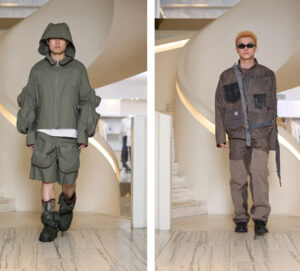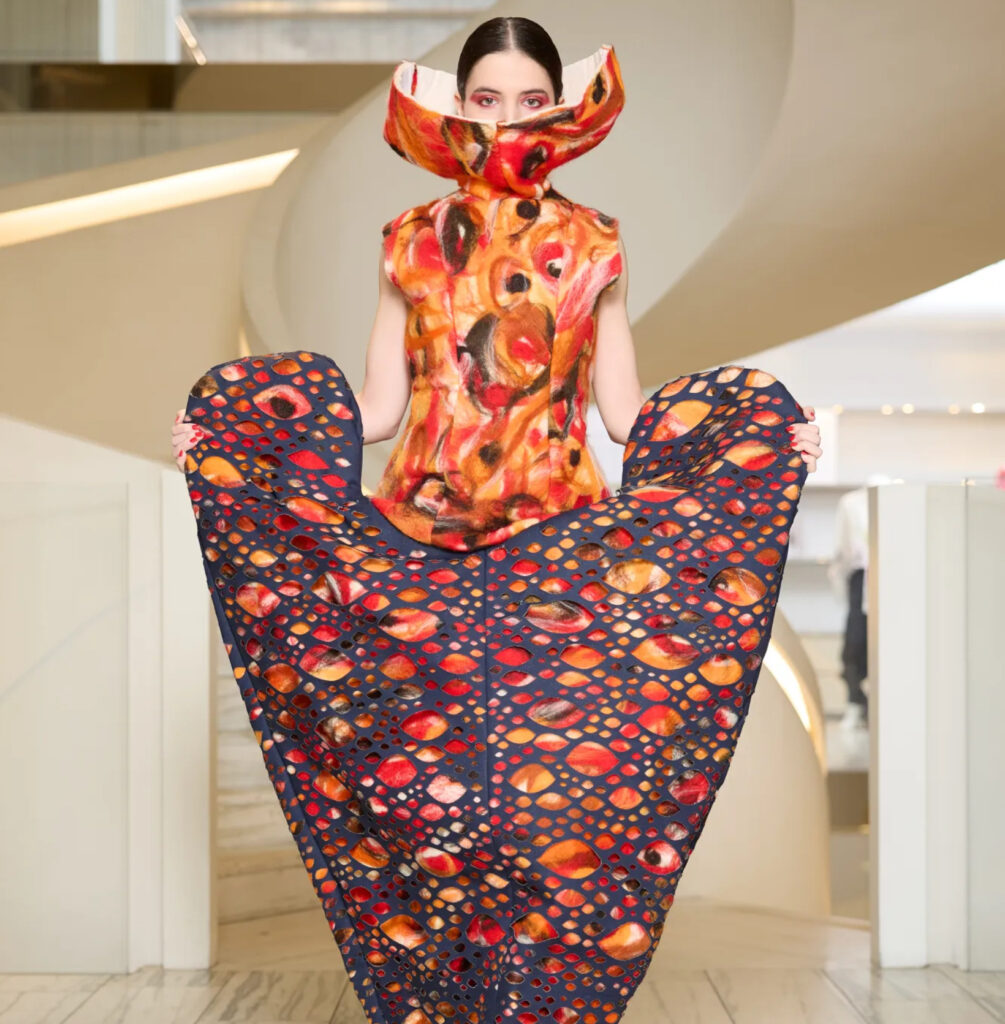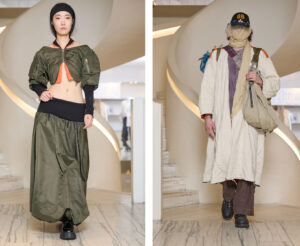
PHOTOGRAPHY: Kaz Senju
Barneys New York Downtown, once the retail altar of high fashion, opened its doors for the final time in 2025—not to mourn its golden past, but to mark a radical, forward-facing rebirth. Where there were once racks of Dries, Saint Laurent, and Comme des Garçons, now stood something even more potent: 283 visionaries from the Parsons School of Design, armed with scissors, silhouettes, and statements. The 2025 BFA showcase, titled “A Common Thread,” transformed the hollowed shell of Barneys into a crucible of possibility. In doing so, it rewrote both the legacy of the building and the parameters of fashion itself.
This was not a show staged in reverence. It was an insurgency in stitches. The decision to hold the showcase at Barneys was not a nostalgic send-off, but an intentional act of reclamation. The students—Gen Z’s clearest sartorial thinkers—turned the site of luxury consumption into a stage for critique, memory, and experimentation. Fashion here was less about perfection and more about provocation.
Armor, Identity, and Disruption
The opening acts set the tone for a showcase charged with commentary. Designer June Chen sent out a series of breastplate-inspired tops—rigid, elegant, and steeped in the visual language of samurai armor. These weren’t mere garments, but declarations of resilience. In a time of social volatility and personal boundary renegotiation, Chen’s pieces operated as protective shells, signaling that the body itself had become politicized terrain.
Elsewhere, Daewoong (Dae) Um and Laurence Wei distorted the streetwear silhouette into high-art territory. Their designs carried the rhythm of hoodies, puffers, and cargos, but warped and twisted into architectural shapes and jarring textures. The line between street and studio dissolved. These weren’t just clothes; they were spatial arguments—collisions of fabric, form, and identity.
Caitlyn Lim approached tailoring with narrative precision. Her suiting, while grounded in tradition, veered toward character construction. Not costume, not cosplay—but a deeper meditation on persona and fluid identity. A sharply-cut blazer might suggest a corporate figure, but Lim’s strategic asymmetry and theatrical proportions hinted at something more: gender play, power inversion, even meta-performance.
Softness as Strategy
Yet, the collection didn’t reside solely in the realm of protection and confrontation. Softness, surrealism, and sentimentality had their moment, too. Jizhuo Li’s pastel dresses were inspired by ball-jointed dolls—a tender and uncanny evocation of childhood memory, fragility, and artificial perfection. Her work glistened like edible sugar sculpture, but beneath the surface was something else: the unnerving stillness of objects made to mimic emotion. It was not escape, but dream as resistance.
Ryan Gdovin offered one of the most poignant takes on craft with his intricate beadwork, which wove shimmering patterns into silhouettes that hovered between devotional and modernist. There was something ceremonial in his process, a reminder that even the smallest embellishment carries a cultural and emotional weight. His garments moved like rituals—precise, reverent, but alive.
Material Messages and Process-Based Power
If there was one common thread uniting the show (beyond the obvious title), it was transformation—of material, of form, of message. Parsons has long trained its students to question, but this year’s class took that inquiry further. Many of the designers blurred the line between finished product and working process. Deconstructed hems were not signs of incompletion but invitations to interpret. Patchwork became code. Upcycled textiles held memories from other garments, other bodies, other contexts.
Across the floor, a garment might look unfinished, but that was the point. These clothes weren’t asking for approval—they were asking for conversation.
Barneys as Metaphor
Choosing Barneys as the venue turned the show into more than a graduation—it became a performance of reclamation. Once a gatekeeper of high fashion, Barneys symbolized aspiration, elitism, and polished consumerism. By flooding it with unpolished, unfiltered, radically experimental student work, Parsons flipped the narrative. The building became a canvas, a vessel, a contradiction. Instead of selling fantasy, it now held possibility.
The juxtaposition of young designers amid faded signage and luxe marble counters worked to amplify the stakes. It asked a critical question: What happens when the old temples of fashion fall? Who gets to rebuild them—and how?
Multiplicity Over Monolith
What stood out above all else was the refusal to conform to any singular aesthetic. This was not a show about trends. There were no obvious microseason themes or market-ready capsules. Instead, there was divergence—an embrace of multiple truths. Gender fluidity, cultural specificity, craft, technology, archival reference, and speculative futurism all lived side by side. The showcase wasn’t unified in style, but in spirit. The collective statement: fashion isn’t monolithic. It never was.
Many pieces carried diaristic elements—stitched text, family photographs printed on fabric, poetry in pockets. Designers drew from grief, migration, rebellion, religion, even meme culture. Clothing was treated as page, altar, battlefield, or diary. Every look carried both intimacy and confrontation.
A Generation Refusing to Wait
This generation of designers doesn’t wait for permission. They’ve grown up in crisis—economic, environmental, social—and understand that fashion cannot afford to be decorative escapism alone. They’re not here to merely dress the body; they’re here to ask what the body represents in an age of surveillance, displacement, burnout, and reinvention.
Yet, what resonated most was the optimism. Even in garments that protected or protested, there was belief—in self, in storytelling, in the future. These students still believe in the power of clothing to communicate, to heal, to change minds. In their hands, fashion remains a living language.
Impression: One Last Show, 283 First Steps
As the lights dimmed on Barneys for the final time, the spirit inside could not be extinguished. The space, long defined by fashion’s past, was given over to its future—and that future walked, draped, padded, beaded, and stitched across the runway with audacity. A Common Thread was more than a graduation show; it was an exhale of creative urgency.
283 designers stood where luxury once towered, not to pay tribute but to take space. In doing so, they offered a lesson to the industry: Fashion’s next chapter is not about perfection. It’s about presence—radical, diverse, and unafraid.
No comments yet.








